Yak-44E - aircraft radar watch and guidance
The development of the Yak-44E aircraft radar aircraft is directly connected with the creation of aircraft carriers of the USSR, as well as with the ever-growing importance of information support for the actions of the naval aviation, especially at a great distance from the airfields.
As you know, in the formation of concepts for the creation and use of aircraft carriers in the USSR, and later in Russia, very controversial and inconsistent decisions were made that led to similar decisions during the development of technical policy and the development of aircraft for these vessels.
Indeed, the modern Russian aircraft carrier fleet consists of a single ship and two dozen Su-33 aircraft. However, even these forces that are part of the ship grouping are helpless if there is no timely information about the surface and air enemy, which is most effectively provided only by the ship’s aircraft of the radar watch and guidance operating as part of the aircraft carrier’s air group.
The problem of information support of ship groupings is solved by installing specials. radio complex on various platforms, which are considered airplanes, helicopters, balloons, convertible planes, airships, UAVs, as well as ships. Currently, the most efficient platforms are aircraft. The most successful project in this area is the aircraft RLDN Yak-44E, developed by the Design Bureau. Yakovlev. The creation of this aircraft was preceded by work on promising aircraft carriers.
In 1968, simultaneously with the development of the anti-submarine cruiser of the 1143 project in the Nevsky Design Bureau, research began on the appearance of an aircraft carrier with an ejection take-off aircraft (project 1160).
Initially, the multipurpose MiG-23А multi-purpose fighter aircraft with variable wing sweep, P-42 subsonic anti-submarine defense aircraft, Su-24K naval supersonic attack aircraft with variable wing sweep, as well as Ka-K-5 supersonic attack aircraft Ka-X-NNXXK, as well as deck helicopters Ka-X-NNXXK with variable wing sweep, as well as deck helicopters Ka-X-NNXXK with variable wing sweep, as well as deck helicopters Ka-X-NNXXK with variable wing sweep, as well as deck helicopters KA-252K, as well as Ka-KN-XNUMX supersonic attack aircraft with variable wing sweep, as well as deck-type Ka-K-59 helicopter.
But in 1972, in the advance design of the aircraft carrier they included several ship variants of the Su-27 front-line fighter. Now air group consisted of 12 Su-29K or Su-27K, 12 Su-28K, 4 scouts designators Su-28KRTS, 6 aircraft ASW P-42, 4 planes P-42 in the embodiment, radar surveillance and guidance and 8 helicopters anti-submarine defense Ka-252.
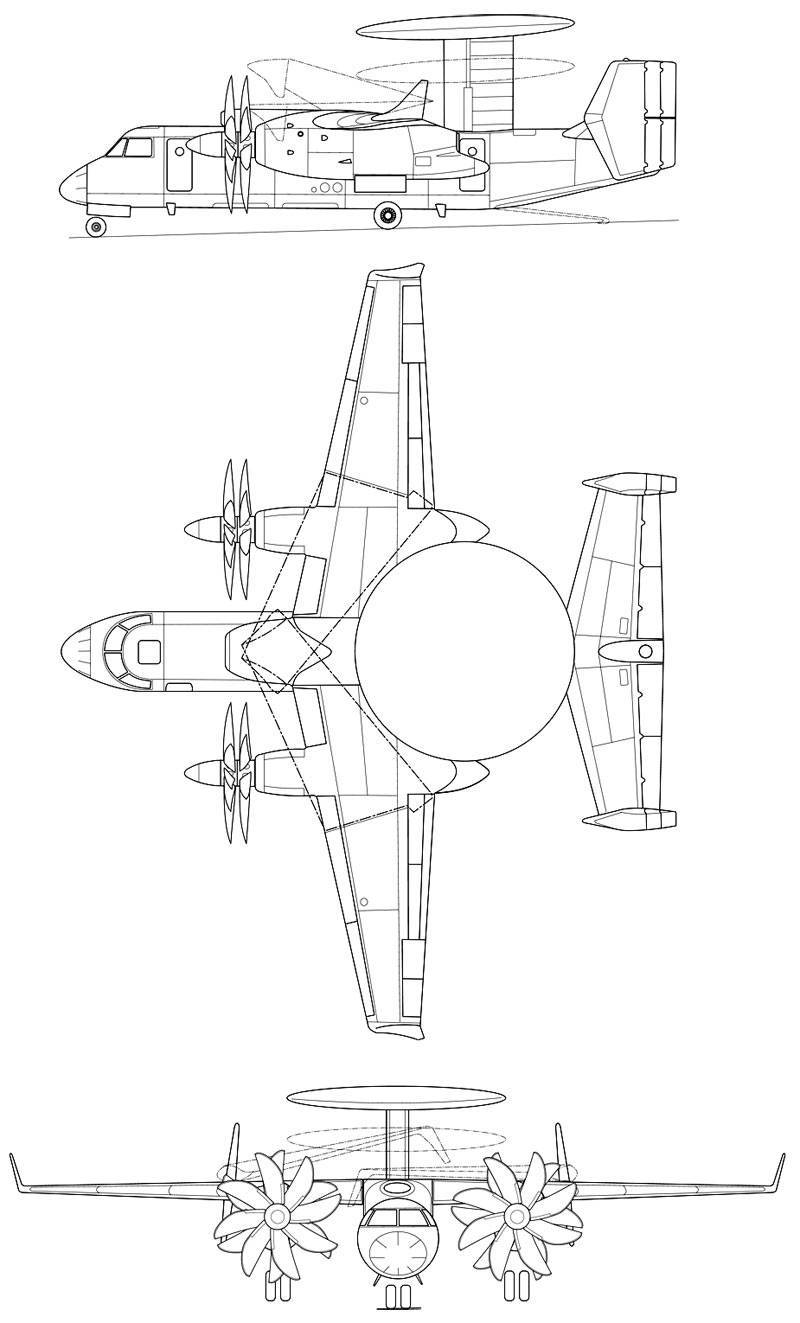
Subsonic anti-submarine defense aircraft P-42 was developed by OKB. Beriev according to the decision of the USSR Council of Ministers Commission on Military-Industrial Issues of 5 June 1971. P-42 in the general scheme was largely repeated by the US Navy S-3 "Viking" anti-submarine defense aircraft. The machine was carried out according to the high-wing scheme with a moderately swept wing, classic trapezoidal empennage with rudders and height, and two D-36 engines under the wing in the gondolas.
The take-off of the aircraft was to be carried out from the ship's catapult, and the design of the chassis and airframe were calculated for landing with braking by an air-arm finisher. The keel and the wing console P-42 to save space when stored in the hangar and on the deck of an aircraft carrier folded.
In addition to the main variant of anti-submarine defense, they planned to develop variants of the deck aircraft of the radar patrol, tanker, transport, search and rescue, etc. The development of the preliminary design of the P-42 was completed in the 1972 year. In 1976, flight tests of a prototype aircraft were to begin.
The first was the design of the anti-submarine defense aircraft P-42, and the development of the P-42 variant of the radar watch and guidance was postponed. But the fighters of the aircraft group of the 1160 project ship could not effectively provide the air defense of the naval unit, which was the main task of the aircraft carrier, since there was no shipborne radar patrol aircraft to control their combat operations.
In the spring of 1976, on the basis of the NPKB development work on aircraft carriers, the government adopted a resolution to develop in 1976-1977 and create by the 1985, two atomic aircraft carriers of the 1153 project. According to the concept, the court data did not differ from the 1160 project, but their air group was reduced from 60-70 aircraft to 50.
The construction of the 1153 heavy aircraft cruisers of the 1977 project in November was abandoned, and the construction of subsequent 1143 vessels, starting with the fifth, was decided to take into account not only the Ka-252 helicopters and the VTs of the Yak-141 type, but also the Su-25K and Su- 27K - aircraft ejection takeoff.
For the first time, the Yak-44 is mentioned in the terms of reference for the development of the heavy aircraft-carrying cruiser of the 11435 project from November 1980 of the year as a radar patrol aircraft, which is part of the aircraft carrier's wing. The 11435 project involved the creation of a ship with a displacement of 55 ths. Tons with an aircraft group of 46 aircraft (aircraft RLDN Yak-44E, MiG-29K, Su-27K, Yak-141 and Ka-27) helicopters. In the future, they refused to carry out this TTZ, after which the aircraft was created for the aircraft wing of the aircraft carrier of the 27 Ulyanovsk project. Option airfield-based planned to deliver to the air force.
In April, 1981 decided to upgrade the second heavy aircraft carrier under construction of the 11434 project in the direction of increasing the aircraft’s air group to 40 aircraft with the inclusion of MiG-29K and Su-27K fighters. In the forward part of the flight deck, the construction of a springboard was provided for the take-off of the fighters.
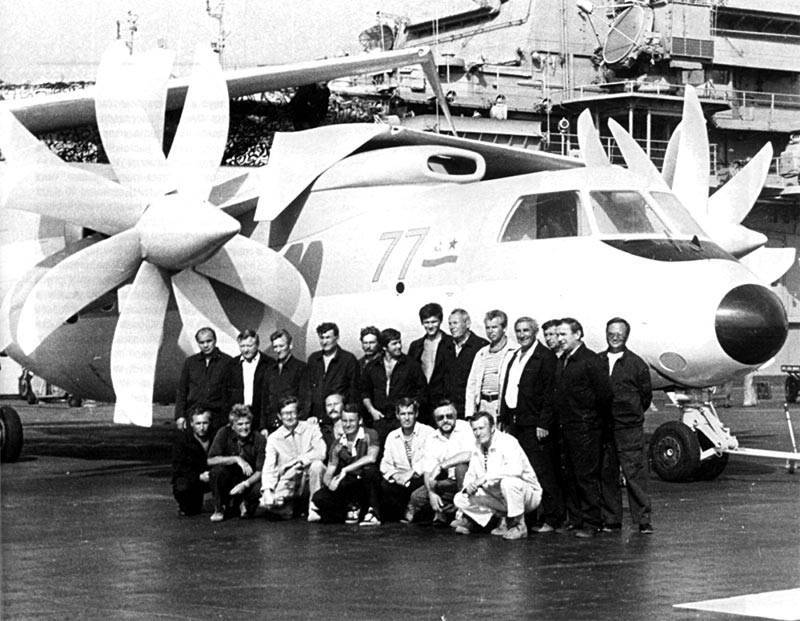
Photo on the memory after testing the operation of the layout of the Yak-44E on TAKR "Tbilisi" Ave. 11435, September 1990 (http://forums.airbase.ru)
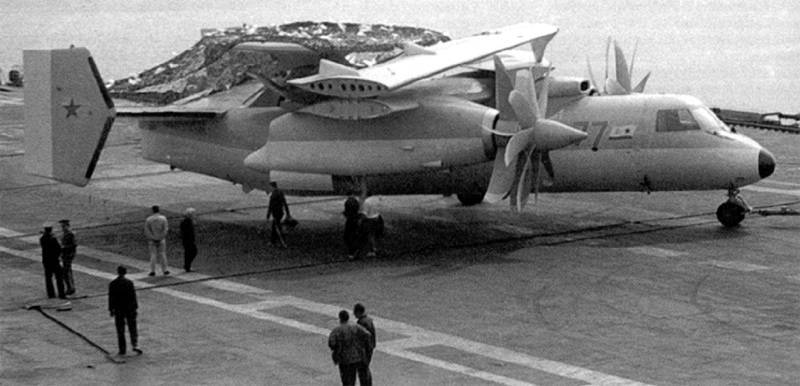
The model of the Yak-44E on the flight deck of the TAKR "Tbilisi" Ave. 11435, September 1990 (http://forums.airbase.ru)
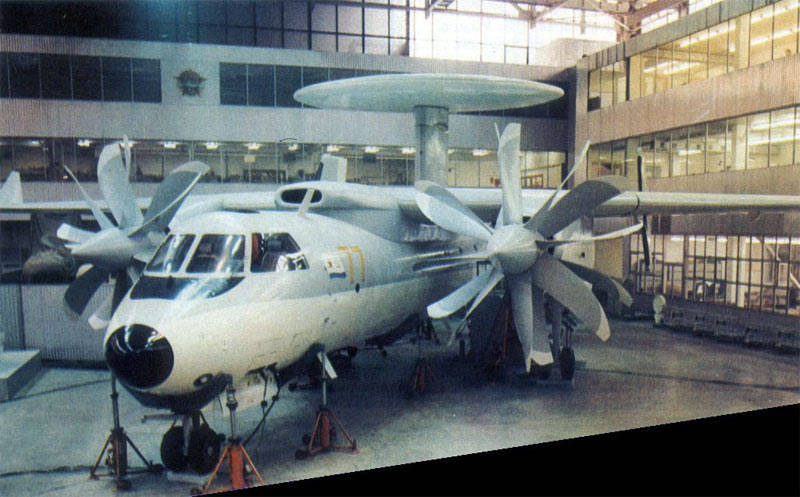
Full-size mock-up of DRLOIU Yak-44E aircraft (http://militaryphotos.net)
For information support of the aircraft carrier grouping ships and the management of combat operations of fighters, the radar patrol and guidance aircraft Yak-11434E were included in the aircraft group of the aircraft carrier of the 44 project. The development of the Yak-44E was given by the Yakovlev design bureau in 1979.
By November 1979, OKB im. Yakovleva prepared those. proposal for the design of an aircraft based on the deck of an aircraft carrier or land aerodromes. We considered two options for the radio complex - the Fakel (the radar was located inside the fuselage in the stern and fore) and the E-700 (the all-round antenna was located above the fuselage on the pylon). In March 1980, at a meeting with S. Gorshkov, Commander-in-Chief of the Naval fleet Of the Soviet Union, a decision was made to create an aircraft with the Fakel radio complex.
Due to significant problems with the creation of the Fakel radio-technical complex in March 1983, the development of the corresponding version of the aircraft design was stopped. In October 1984 of the year in connection with the failure of the fleet from the draft deck version of the An-71 long-range radar detection and control aircraft, work continued on the Yak-44E without lift engines, equipped with turboprop-fan engines and the A-700 radar antenna antenna over the fuselage on the pylon. In September, 1988, an advance design of the new version of the aircraft was prepared. In January, the 1989 of the year adopted a Council of Ministers Decree on the creation of a multi-purpose radar patrol aircraft Yak-44E with the radio complex E-700. In June, the 1989 of the year was started with detailed design. They made a full-size constructive-technological model and a model on the scale 1: 5 intended for radio engineering studies. To test the engine D-27 created the aircraft laboratory Yak-42LL. In TsAGI, in the period from 1988 to 1991, the year carried out research on the dynamics of the deck Yak-44RLD and safety during take-off with the use of a springboard.
The Air Force Flight Research Institute at the ground-based test complex in Saki (Crimea) successfully conducted a unique experiment in controlling the pre-landing maneuvering and landing of a group of planes consisting of two MiG-29 and one An-24 imitator Yak-44E. The aircraft made an approach at a given pace. The protection of the draft technical design and the layout of the Yak-44 took place in January of the 1990 year. In terms of its main characteristics, the aircraft significantly exceeded the latest versions of the Hokai E-2С, the only aircraft of this class with an ejection take-off in the world.
The construction of prototypes and further serial production were planned to be carried out at the Tashkent Aviation Plant. The construction of the first flight pattern was begun in the 1990 year. The cockpit and the middle part of the fuselage were manufactured at the pilot plant of the OKB Design Bureau. Yakovlev, manufacturing the antenna fairing was engaged in conjunction with the Ulyanovsk APO, the wing - in Ulan-Ude. 1990 was decided to work out the storage and transportation of the Yak-44E on aircraft carriers using a simplified weight and size model. The layout should have been built on the basis of 1990, protected in January, of a constructive-technological layout. In August, the 1990 of the year, the Design Bureau completed the revision of the layout. The model was disassembled and transported to Sevastopol, where it was again assembled aboard the heavy aircraft-carrying cruiser “Tbilisi”. Assessment of the characteristics of the Yak-44E on board the cruiser was carried out in a short time - during the first half of September 1990. In the course of these works, the possibilities of mooring and towing the aircraft in the hangar and on the flight deck, rolling onto the platform and climbing onto the deck, descending into the hangar, installing into a regular place, pairing the vehicle with technical support posts on the deck and in the hangar were checked. At the end of the work, the model of the aircraft was again moved to the Yakovlev Design Bureau in Moscow.
In the 1992 year, after the collapse of the Soviet Union, the financing of work on the Yak-44E aircraft was stopped at the stage of building prototypes for testing. In anticipation of the MAKS-1995, the Yak-44E was supposed to be shown, but the Ministry of Defense banned the show.
The radar patrol aircraft Yak-44 is built according to the normal aerodynamic configuration. In the deck version, the aircraft had a folding radar antenna pylon and folding wings. Double tail. The fuselage has a semi-monococcal circular section. The fuselage is equipped with a working cabin for operators, a rest compartment designed for one person, an air-conditioned compartment with equipment, a canteen and a bathroom. Trapezoidal wing in the plan. Wing mechanization - along the entire trailing edge. Foldable wing console. To reduce the inductive impedance, end flaps were installed. Chassis tricycle, with a nose strut, retractable. The fuel is placed in the caisson tanks in the stabilizer and the root of the wing.
Initially, the Yak-44E was supposed to install a combined powerplant, which consisted of two cruise turboprop engines located under the wing and four turbojet lifting engines located in the fuselage. Lifting engines should be used only during takeoff and landing to reduce the speed of the Yak-44E from the deck of the aircraft carrier and the approach of the aircraft to land.
During the take-off of the Yak-44 with this powerplant from a springboard, the estimated takeoff length was about 150-200 meters, the estimated cruising speed - 450 km / h, the duration of patrolling - 5 hours. The RTC of the aircraft detected enemy planes at a distance from 150 to 200 km from the aircraft carrier and pointed fighters at them. The detection of surface targets was carried out at a distance of more than 300 km. The crew of the aircraft - three people.
However, the placement in the fuselage of the Yak-44E 4-x lifting engines and significant reserves of fuel made it difficult for the layout of the aircraft RTK systems.
In the final version (project 1984 of the year), the Yak-44E was equipped with two D-27 turboprop-fan engines developed by Zaporozhye Machine-Building Design Bureau Progress. According to its characteristics, the D-27 engine has no analogues in the global aircraft engine building industry. The use of these engines with a heightened load on the take-off mode, as well as taking into account the wing airflow, made it possible to provide a springboard Yak-44E springboard from aircraft carriers. Both of the key engine elements that determine the high technological level — the gearbox and the fan-driver — are Russian-made.
The choice of this engine for the Yak-44E aircraft was due to the fact that at high subsonic cruising speeds it has better efficiency, compared to modern turbojet dual-engine engines. In addition, in takeoff mode, the D-27 provides the best thrust-to-weight ratio and traction characteristics. The weight of the aircraft was sufficient for the take-off of the aircraft from the springboard of the heavy aircraft-carrying cruiser Admiral Kuznetsov and the increase of the lift force of the wing due to blowing its surface.
These qualities are also important because the Yak-44E was supposed to create a family of airfield and deck-based aircraft with various cruising speeds. In the whole range of these speeds, the D-27 has advantages over turbojet bypass and turboprop engines.
The take-off power of the D-27 engines was HP 13880. each (according to other data - on 14000 hp), and cruising - on 6750 hp each. The engine length was equal to 4198 millimeters. Weight without a ventilator - 1650 kg. The diameter of the fan driver was 4,5 m. The number of blades - 8 and 6. In the cruise mode, the specific fuel consumption per hour was 0.17 kg / hp, and in the cruise mode - from 0,13 to 0,143 kg / hp. at one o'clock.
The ground tests of the D-27 turboprop-fan engine were carried out in 1988, and in 1990, it underwent a series of studies. For this purpose, a flying IL-76LL laboratory was used at LII VVS. The D-27 engine is equipped with a two-stage compressor, a high-temperature combustion chamber (has a uniform temperature field at the turbine inlet), a three-shaft turbine (has an active control system for radial clearances), a single-stage compact differential gearbox with an integrated thrust meter, a two-row screw-driver CB-27, an electronic control system FADEC type. The reducer of the turbopropfan engine D-27 was developed by ZMKB Progress, the production was carried out by the Moscow machine-building production enterprise Salyut.
The screw fan is a high-loaded supersonic high-speed propeller with large-width saber blades. The main advantage of this propeller is high efficiency at high transonic flight speeds, which are comparable to efficiency. normal propeller at medium speeds. The screw fan CB-27 is designed and manufactured by SKBM (today OAO NPP Aerosila). CB-27 double-row, with the opposite direction of rotation of the blades, vane-reversible, coaxial, automatic, equipped with an electric anti-icing system of the fairing and blades. For the manufacture of blades used composite materials. The design of the mounting blades provides replacement blades during operation. The hydromechanical regulator together with the electronic regulator provided the pitch fan control, reorganization and maintenance of the rotation speed on the electronic channel. Accuracy was ± 0,5%. Maximum speed - 1200 revolutions per minute.
The tests of the D-27 with a power-driven fan, including for the Yak-44E, were carried out on an airplane - the Yak-42E-LL flying laboratory with one D-236 engine, which is a reduced dimensionality of the D-27 engine. 15 March 1991, the first flight of the flying laboratory.
The complex of the equipment of the Yak-44 radar patrol aircraft includes a set of information and information-control systems, digital computing means, indication and control systems connected by multiplex information exchange channels.
An E-700 radar station with a circular viewing radar provided for the detection of air targets at a distance of 150-200 km and surface targets - more than 300 km.
Flight-navigation complex provides continuous automatic determination of coordinates according to the information of inertial systems with correction according to the information of the radio-technical systems of satellite, long-range and short-range navigation. PNK provides the formation and display of information about the state of the aircraft systems and the parameters of the power plant.
The integrated control system provided automatic piloting in the vertical and horizontal planes along the programmed route, as well as automatic landing using signals from deck or ground radio engineering means of landing, stabilization of the set values of height, speed, roll, course, pitch.
The meteo-navigation radar station provides an indication of information about meteorological formations, as well as issuing recommendations on the optimal route for their flight.
On-board automated monitoring system provides control of the technical condition and operability of systems and equipment during the flight, documenting the results of monitoring with further transmission of data via telemetry communication channels to the station of technical bases, monitoring operational limitations, predicting the technical condition, troubleshooting, taking into account the balance of equipment and systems .
Electro-remote control system is a complex analog-digital control system for aircraft and wing mechanization, providing flight at various aircraft alignments associated with various equipment and refueling options.
Modifications
Yak-44E - carrier-based long-range radar detection aircraft, built layout.
Yak-44PLO - anti-submarine aircraft. Avanproject aircraft, created no later than 1990 year. Technical design was not conducted. Assumed to create a ship and the base versions of the aircraft.
Yak-44E ground - a modification of the aircraft for early warning radar and control for airdrome-based. It was supposed to deliver to the Air Force of the USSR. The aircraft project was defended in the fall of 1991. The aircraft has a significantly increased patrol time, the tactical and technical characteristics of the radio-technical complex have been improved.
Yak-44 patrol / border - modification to control the border. The design of this aircraft in terms of the design bureau was scheduled to 1994 year.
Yak-44 transport.
Yak-44 rescue.
Flight performance (flight data calculated):
Length - 20,39 m.
Height - 5,7 m.
Wingspan - 25,70 m.
Swing with folded wing - 12,5 m.
Wing area - 88 m2.
The diameter of the fuselage - 2,7 m.
Radome radome diameter - 7,3 m.
Empty weight - 21200 kg.
Maximum take-off weight - 30400 kg.
Engine type - X-NUMX turbopropfan engines D-2
Power - 2x4700 hp
Screw diameter - 4,5 m.
Fuel stock - 10,5 t.
Maximum speed - 740 km / h.
Cruising speed - 700 km / h.
Ferry range -> 4000 km.
Patrol speed - 500-650 km / h.
Patrol height - 3-11 km.
Landing speed - 185 km / h.
Practical ceiling - 13 km.
Range range - km.
Azimuth Viewing Area - 360 deg.
The viewing area height - km.
Target detection range:
- aerial target with EPR 3 m² - 250 km;
- cruise missile AGM-84 - 165 km;
- cruise missile AGM-86 - 220 km.
The number of simultaneously accompanied targets - 150.
The height range for detecting airborne targets is 5-30000 m.
The speed range of the detected targets is 40-3500 km / h.
The number of simultaneously accompanied targets on the background of 1500 - 150.
Flight crew - 2 people.
Radio crew - 4 people.
Based on materials:
www.paralay.com
militaryrussia.ru
www.airwar.ru
alternathistory.org.ua
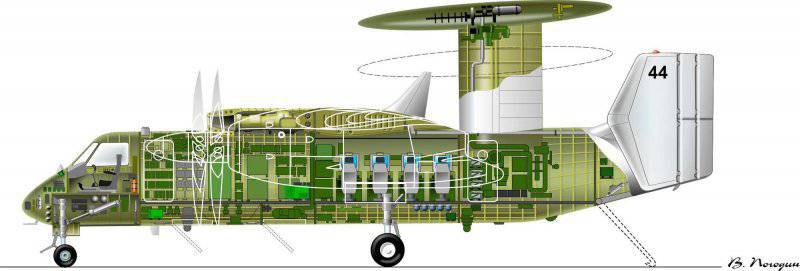
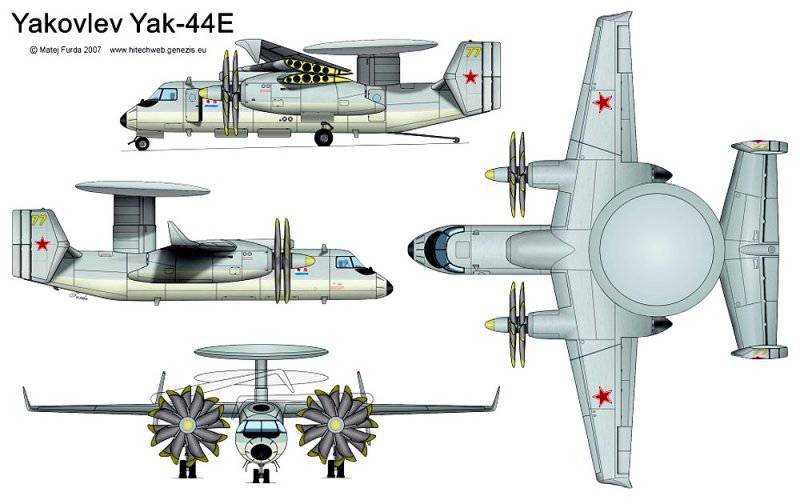
Information